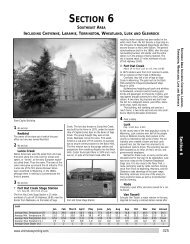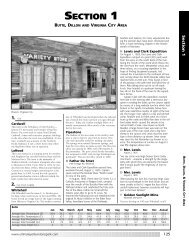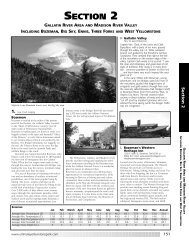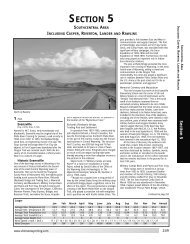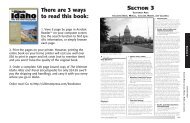SECTION 3 - New Times Media Corporation
SECTION 3 - New Times Media Corporation
SECTION 3 - New Times Media Corporation
You also want an ePaper? Increase the reach of your titles
YUMPU automatically turns print PDFs into web optimized ePapers that Google loves.
Section 3<br />
All Wyoming Area Codes are 307<br />
corral. In the early 1900’s area residents<br />
brought survivors of the fight, both Indian and<br />
white, to the area in hopes of pinpointing the<br />
exact location of the corral. Unfortunately, the<br />
survivors were not at the site at the same<br />
time and did not agree on the location. One<br />
site chosen is the location laid out near where<br />
you are standing. The other location is a brass<br />
marker several hundred yards to the southeast.<br />
There has been much study in an<br />
attempt to resolve this debate, including correspondence<br />
with early residents, aerial photography,<br />
and archaeological surverys. The<br />
strongest evidence come from archaeology<br />
done over several years, which indicates that<br />
the laid out corral may be close to correct.<br />
But if the actual participants could not agree<br />
on a location, then the best and most accurate<br />
description of the location of the corral is<br />
to say that it was placed somewhere atop the<br />
plateau, between Big and Little Piney Creeks.<br />
As to the other controversies, Indian casualties<br />
can probably be estimated at between six and<br />
sixty and the time of the fight from 8:00 A.M.<br />
to 1:00 P.M. As with all historical events<br />
research will continue and new facts will<br />
come to the surface.<br />
F Kimmeri’s Restaurant<br />
6 N Piney Rd in Story. 683-3332<br />
8 Food, Lodging<br />
T DeSmet Lake<br />
At I-90 Exit 51<br />
The lake was named for Father Pierre DeSmet, a<br />
Jesuit missionary back in the early 1800s. It is<br />
now known for its terrific fishing opportunities,<br />
boating and skiing, and swimming. There are<br />
many facilities at the lake including ramps, docks,<br />
campgrounds and picnic shelters. You might even<br />
see the legendary “Smetty”, the lake monster.<br />
T DeSmet Lake Monster<br />
Lake Desmet not only attracts fishermen looking<br />
to catch the great rainbow trout or crappies it<br />
provides, but “Smetty” is another great attraction.<br />
Smetty is the legendary creature believed to<br />
inhabit Lake Desmet.<br />
The lake is named for a Jesuit missionary<br />
priest to the Indians, Father Pierre DeSmet,<br />
back in the early 1800’s. Rumor has it that the<br />
Indians were so frightened by this body of<br />
water, they refused to camp along the red shale<br />
shores. Some say that the Sioux Indians<br />
believed the waters had healing powers and the<br />
ability to prompt visions. The tribe legend was<br />
that a young brave turned against the love of<br />
his life because he was overpowered by the<br />
charms of a water maiden rising from its<br />
depths. His intended wife-to-be was so distraught<br />
by his rejection she subsequently<br />
drowned herself. Her father, the tribal chief<br />
seeking revenge, swiftly administered justice to<br />
the unfaithful young man. In the darkness of<br />
windy Wyoming nights, his spirit supposedly<br />
wanders around the shore bemoaning the loss<br />
of his Indian maiden.<br />
Local ranchers often told stories about seeing<br />
a 30 to 40 foot long looking like a “long<br />
telephone pole with a lard bucket attached.”<br />
Other recorded physical characteristics include<br />
a “bony ridge along the back, with a resemblance<br />
to a horse’s head coming out of the<br />
water in a swimming motion.”<br />
There have been tales about the lake’s dark<br />
side that range from a monster resembling an<br />
160<br />
alligator rising from the waters to a Loch Nesstype<br />
creature that seized an Indian papoose and<br />
disappeared into the murky depths.<br />
When imagination runs high, “Smetty” is<br />
said to dwell in the so-called bottomless lake’s<br />
subterranean caverns sometimes speculated to<br />
be a faraway outlet from the Pacific Ocean.<br />
Edward Gillette, author of “Locating the Iron<br />
Trail” wrote a book in 1925 chronicling the tales<br />
and observations surrounding “Smetty.” Visit<br />
Lake Desmet and judge for yourself, but don’t<br />
forget to take your fishing pole and bait so you<br />
don’t miss out on some great fishing!<br />
9 Food, Lodging<br />
Buffalo<br />
Pop. 3,900, Elev. 4,645<br />
Founded in 1879 by homesteaders, cattle<br />
ranchers, and miners, Buffalo was not named<br />
for the animal, but for Buffalo, <strong>New</strong> York,<br />
hometown of one early settler, Alvin J. McCray.<br />
By 1883, there were a dozen saloons in town,<br />
but no churches. While an old buffalo trail did<br />
once run down Main Street, Buffalo’s streets are<br />
most famous for being the only place in the US<br />
where you can make a legal U-turn on a highway<br />
bridge, right in the middle of town. As the<br />
Johnson County Seat, Buffalo also claims the<br />
distinction of having hosted the oldest county<br />
fair in the state in 1887.<br />
T Dry Creek Petrified Tree Forest<br />
I-90 E from Buffalo to the Red Hills exit,<br />
drive N off exit for 7 mi to the Petrified Tree<br />
Area access road<br />
The Dry Creek Petrified Tree Environmental<br />
Education Area (EEA), set aside as such in 1978,<br />
is located about 9 miles east of Buffalo,<br />
Wyoming. A parking area, picnic table, and<br />
interpretive facilities can be found here.<br />
As you travel around a loop nature trail<br />
about 0.8 mile long, you will go back 60 million<br />
years to the geologic era of the Early Eocene<br />
when this area was shaded woodlands and<br />
mossy glades. You will learn how the uplifting of<br />
the Big Horn Mountains helped to create the<br />
prairie ecosystem we see today. And you will<br />
also learn about early vegetation and the formation<br />
of coal, scoria, petrified trees and other<br />
indicators of the past.<br />
This area was very different from what can<br />
be seen today. Giant trees grew in a jungle-like<br />
area somewhat like the Okefenokee Swamp in<br />
southern Georgia. A large system of rivers<br />
flowed north to a distant ocean. Huge swamps<br />
filled the wide, flat plain between the Big Horn<br />
Mountains and the Black Hills. There may have<br />
been turtles, crocodile-like creatures, large<br />
fished similar to modern gars, and primitive<br />
mammals and birds.<br />
Scoria is a sort of natural brick formed from<br />
shale or sandstone that has been “fired” when<br />
coal seams caught fire and burned back into the<br />
ground. Scoria can be crushed and used as a<br />
rock aggregate for road pavement, hence some<br />
of the red color roads in the area, and as a road<br />
base for unimproved roads. The red color is<br />
produced by iron oxides in the rock. Scoria can<br />
be crushed and used as a rock aggregate for<br />
road pavement; hence, some of the red-colored<br />
roads in the area, and as a road base for unimproved<br />
roads.<br />
Coal forms slowly over great periods of time.<br />
The coal beds in the area originally accumulated<br />
as peat deposits that formed from the leaves,<br />
branches, stems, and roots of trees and other<br />
plants that grew in the swamps. The peat beds<br />
probably were buried when a nearby river flooded,<br />
covering the area with sand and mud. After<br />
millions of years under thousands of feet of sediment,<br />
the peat gradually changed to coal. (One<br />
coal seam near Buffalo, the Healey, is about 200<br />
feet thick in places.)<br />
As erosion and uplifting began to change the<br />
earth’s surface, many coal seams were exposed to<br />
air and caught fire. As the coal seams burned<br />
back into the hillsides, the intense heat changes<br />
the normally soft brown and gray rocks to a<br />
hard red material—scoria. At station 2 you will<br />
learn about plants that helped to form the coal.<br />
The ecosystem of the swampy plain played a<br />
significant part in the development of coal, an<br />
important energy resource today.<br />
Article courtesy of Bureau of Land Management.<br />
WHAT MAKES<br />
THE BIG HORNS<br />
SO SPECIAL?<br />
No region in Wyoming is provided with a<br />
more diverse landscape; from lush grasslands<br />
to alpine meadows, and rugged<br />
mountain tops to canyonlands and desert.<br />
Gorgeous canyon country is a hallmark<br />
of the forest. Shell, Tensleep and Crazy<br />
Woman Canyons are among those that can<br />
be enjoyed from your car window. Others,<br />
like Tongue and Devil’s Canyon are better<br />
viewed on foot.<br />
Geology is noteworthy in the Big Horns.<br />
Watch for highway signs that trace the geologic<br />
history of this regin as you travel the<br />
major highways.<br />
One of our many treasures is an abundance<br />
of large mountain meadows. These<br />
natural openings, caused by soil type and<br />
moisture levels, favor grasses and wildflowers<br />
rather than trees. Wildflowers are truly<br />
extraordinary in the Big Horns during June<br />
and July.<br />
Interspersed with mountain meadows<br />
are large patches of cool evergren forest<br />
extending from just above the foothills to<br />
timber line. Ponderosa pine and Douglas-fir<br />
populate the lower slopes with lodgepole<br />
pine, subalpine fir and Englemann spruce at<br />
the higher elevations.<br />
Open landscapes make for great<br />
wildlife viewing as well. Watch for moose<br />
munching on a tasty bite of willow streamside<br />
or a family of mule deer bounding<br />
away, then stopping to look back with large<br />
ears raised and listening.<br />
History buffs come to this region to<br />
explore the land that once felt the footsteps<br />
of legendary giants like Jim Bridger, Lewis<br />
and Clark, Red Cloud, Plenty coups and<br />
Buffalo Bill. Big Horn country was highly valued<br />
by tribes like the Crow, Sioux, Northern<br />
Cheyenne, Eastern Shoshone, and<br />
Arapahoe. Some of the most famous battles<br />
between American Indians and the U.S. military<br />
were waged at the foot of the Big Horn<br />
Mountains or in close proximity.<br />
Source: U.S. Forest Service<br />
Ultimate Wyoming Atlas and Travel Encyclopedia



